Get ahead of the weekend by signing up for our free weekly “In the CLE” newsletter — your guide to fun throughout The Land. Arriving in your inbox every Wednesday, this weekend to-do list fills you in on everything from concerts to museum exhibits — and more. Click here to subscribe.
Seeking the Snowy Owl on Lake Erie’s Winter Shores
In the age of COVID-19, birdwatching has taken off in Northeast Ohio, drawing new, young bird enthusiasts to the hobby. And it doesn’t slow down during the winter, when animals like the snowy owl arrive in Cleveland.
by Annie Nickoloff | Nov. 28, 2022 | 3:26 PM
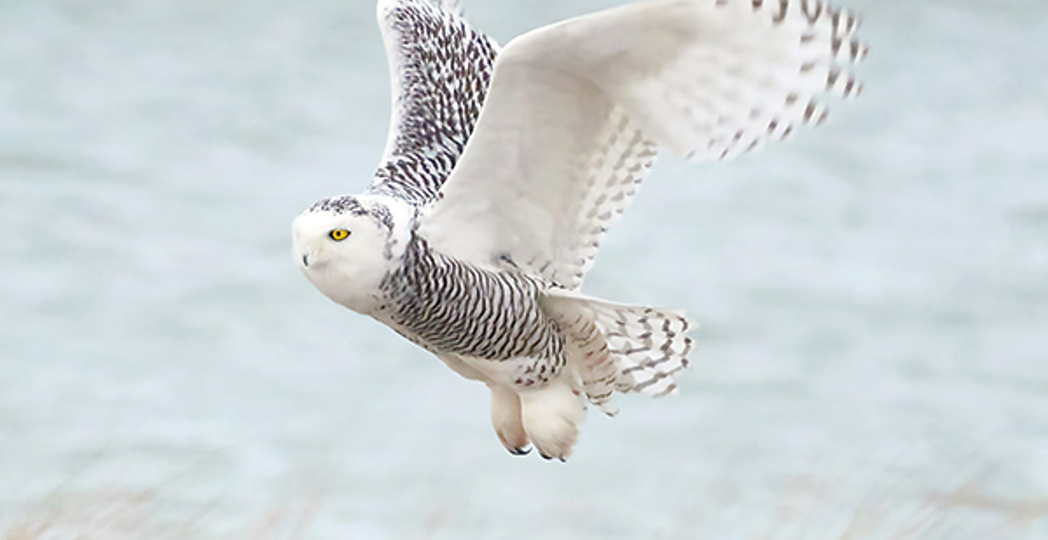
Courtesy Alex Eisengart
The snow was falling, and Alex and Jon Eisengart had a flight to catch.
The father and son were running behind, circling a crowded Cleveland Hopkins Airport parking garage. Their plane to San Diego — where Alex would teach a photography workshop at the city’s bird festival — would depart soon.
Up and up they drove, winding around the garage, looking for a spot to leave their car and, finally, at the very top floor, exposed to the elements, they found an open space. There, Alex saw something else: in the distance, barely visible against the gray-and-white backdrop of a Cleveland winter’s day, a snowy owl. Its bright yellow eyes pierced the dreary scene.
The large Arctic bird was perched at the top of the garage as Alex grabbed his camera and fumbled to a photo-worthy vantage point, tennis shoes soaked from the slush that had gathered on the rooftop lot.
Careful to respect the owl’s space, to not startle it, Alex clicked the shutter on the camera, snapping a few photos before his dad hurried him away. They caught the flight to San Diego. Their plane took off. From their window seat, Alex saw the same bird one more time, soaring into the distance, spooked by the airport action. Once they landed and arrived at the birding event, Alex broke out his camera to share his find with fellow bird enthusiasts.
“When I got to San Diego, it was 80 degrees,” Alex says. “I was like, ‘Look at this — before we came here: A snowy owl.’”
The Great Snowy Owl
The snowy owl is a prized sight among the birding community — a community that continues to grow with younger and more diverse hobbyists, all while the Arctic bird’s population continues to dwindle.
Currently designated as a vulnerable species (one step above “endangered” status in the International Union for Conservation of Nature’s scales), the snowy owl’s population is in a state of steady decline. The IUCN estimates that 14,000-28,000 snowy owls remain in the world — and fewer, every year.
RELATED: Critters of Cleveland: Meet Northeast Ohio's Cute, Resilient and Interesting Animals
The species, maybe best known for its iconic role in the Harry Potter books and movies as the titular character’s pet bird Hedwig, is threatened by climate change. Disruptions in Arctic ecosystems can cause fluctuations in the abundance of lemmings, the bird's primary food source, and create new patterns for the owls' wintertime southward travel.
Regardless, some snowies make their way to Northeast Ohio every November or December. They’re as sure a marker of the winter season as a morning’s frost, but not nearly as prolific.
RELATED: Bobcats are Bouncing Back in Ohio
While other birds — warblers, swallows and more — make their way to vacation in the southern United States during the chilliest Ohio months, some Arctic birds arrive on the frozen shores of Lake Erie for their annual migration, flying thousands of miles for something a little warmer than the extreme cold of their home. (A Cleveland winter might suck for us, but it’s downright balmy for these creatures.)
When the snowy owl shows up, birders take notice.
Online forums and birding apps like eBird, iNaturalist and BirdsEye light up with photos and locations of snowy owl sightings, directing fellow enthusiasts to find the best spots where they can view the bird. Within hours of a sighting, crowds of birders will descend upon local parks, gathering to view and photograph the seasonal visitor. Often they’re waiting for long periods, often in blistering winds.
“Nothing will mobilize the masses like a snowy owl,” says Cleveland Metroparks naturalist Marty Calabrese. “Nothing will throw a wrench in your schedule for the day like when a snowy owl is spotted and you’ve been waiting.”
A Snowy Owl’s Stay
Calabrese says that snowy owls typically arrive in Northeast Ohio from Thanksgiving until March, foraging for small mammals and other birds along the waterfront. The snowy owl stands apart from other owls in that it hunts during the day — making it easier to spot in the sky, unlike the vast majority of nocturnal owls. However, its white winter camouflage makes it harder to see — plus, there’s the fact that ... well, they’re rare.
“There could be one or two for the whole winter,” Calabrese says. “They’re seldom seen.”
There are a few good spots to start looking, though. The tundra-esque runways of local airports are popular hunting grounds for snowy owls. A snowy was spotted at Wendy Park in 2021, Calabrese says — and the Eisengarts spotted one at Headlands Beach in early 2022.
“Cleveland’s lakefront provides a host of advantages, from refuge to food,” Calabrese says.
RELATED: 9 Unique Underwater Creatures That Call Lake Erie Home
Any liquid water source and any established food source indicates a strong birding hot spot in the winter, say the Eisengarts. Small mammals and birds feed the snowy owl, and seed in home feeders can draw in hungry songbirds.
Birdwatching might feature a little less variety when the snow falls, but the hobby doesn’t halt like some of summer’s other outdoorsy activities.
For Alex, who’s been seriously birding for the past three years, the season gives an opportunity to catch less common visitors. He bundles up, faces the winter winds and conditions and heads out with scores of other local birders to look for the snowy owl, the Northern saw-whet owl and others like it.
“I always look for rarities — winter is the best time for rarities,” Alex says.
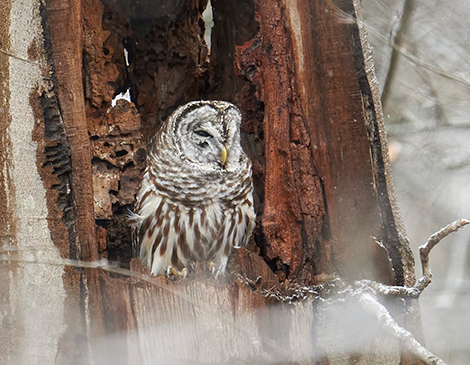
The Game of Birdwatching
Alex, at 15, still needs his parents, sister or grandparents to drive him to his favorite birding spots. Once he gets his driver’s license in the next year, he’ll be able to explore more of Northeast Ohio’s birding scene.
But for now, he’s enjoying it like he always has — often with his dad, who first introduced him to the world of birding. Jon initially pursued birdwatching as an outlet for his photography hobby. On the weekends, Jon would take Alex hiking and see what birds he could shoot in parks near their Beachwood home.
RELATED: 3 Fresh Northeast Ohio Hikes We Love
While Jon would fiddle with his camera, Alex got bored waiting on the trail. Eventually, Jon bought a second camera and birding lens for his son to try out — one that he could still make use of if Alex never ultimately took to the hobby.
“I figured that he wouldn’t use it all the time and when he wasn’t using it, I’d be able to get great pictures of small birds far away that I couldn’t do at the time,” Jon says, “but I never got to use it. Never once got to put it on my lens.”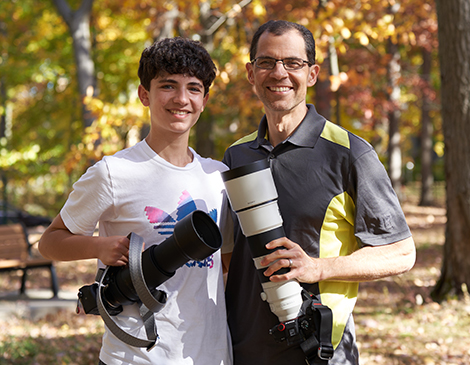
Alex, who formerly played Pokemon Go, the popular augmented reality phone game, quickly latched onto the competitive aspect of birdwatching, fueled by Merlin and eBird, two of the bird world’s most popular identification and tracking apps. Merlin, the more beginner-friendly option, allows users to narrow down birds they see in the wild, based on size, colors, location and bird calls, adding sightings to their “life lists” — a collection of birds they’ve witnessed in the wild. (Alex has 345 birds, and counting, on his life list.)
These apps show birdwatching’s explosion in popularity in recent years. Merlin saw more than three million users open the app in spring and summer 2022, according to the Cornell Lab of Ornithology’s annual report. Daily users tripled compared to 2021.
Before that, the pandemic led to a surge in outdoor interests, including birdwatching. In 2020, following COVID-19’s global surge, sales of birdseed and other backyard birding materials boomed, according to a National Audubon Society report.
“The pandemic gave it a real boost. Everyone was trapped, and they couldn’t go anywhere except for outside,” Alex says. “I think that really brought a lot of people into the hobby. I know it really got me started.”
RELATED: 3 Spots Along The Towpath Trail Where Cleveland's Beauty Shines
At the start, Alex identified straightforward birds — ducks, herons, falcons, crows — based on Merlin’s cues. Now, he studies birds’ behavior while he’s out on a birding hike; on a September walk through Lakefront Nature Preserve, the 15-year-old rattled off details and facts about birds’ characteristics while he named them — sometimes, positively identifying a bird by its flight pattern or by a short burst of peeps.
Alex’s skills have translated into a number of honors and paid birding and photography work.
Through his Instagram page, @kid_with_a_sony, he was contacted by Hunt’s Photo Video, a shop in Boston, which connected him with several paid workshop opportunities around the country and in Ohio and San Diego. Some of his workshop earnings have funneled back into his hobby, even paying for expensive new camera lenses. Alex’s photos have landed in the Audubon Society’s Top 100 photography competition’s youth category three times. In 2021, he was listed fifth for a spunky photo of an American woodcock.
That being said, the teen says he wants to keep birding as a hobby, pursuing a career path that doesn’t involve any chirping.
“As of right now. It’s changing, you know?” Alex says. “I think I’m gonna go into chemistry. I want this on the side because then I can afford a lens and camera, and birding trips.”
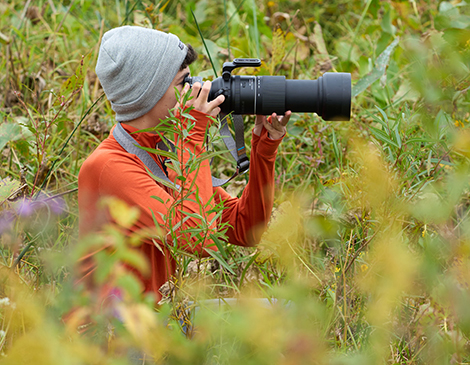
Alex is part of a growing community of young birders and bird photographers, many of whom meet online through Instagram or through organizations like Cornell’s “Young Birders” group. Locally, teens have taken an interest in other ways; for example, a St. Ignatius senior recently founded the school’s birding club.
It’s a shift for the hobby’s demographics — in 2016, most birders were 55 or older, according to the U.S. Fish and Wildlife Service.
RELATED: Woman Hikes Every Mile Of Cuyahoga Valley National Park
The organization defines a “birder” pretty broadly, stating that 18% of the U.S. population could be part of the category. “To be counted as a birder, an individual must have either taken a trip one mile or more from home for the primary purpose of observing birds and/or closely observed or tried to identify birds around the home.” No fancy notebooks or binoculars required.
Young birders like Alex tend to use apps to track their birdwatching, and eBird and Merlin continue to welcome new birders. In 2021, eBird welcomed 116,000 new users and Merlin, 2 million.
“I saw this one statistic that said that 25% of people are in one way, shape or form a birder,” Alex says. “I think it really is catching on, even if you’re not crazy serious, right?”
Birding Beginners
Compared to other outdoor hobbies, birdwatching has a low barrier for entry. Merlin and apps like it are free to download and use for folks who want to dig in. Though it involves some time spent outdoors, birdwatching isn’t particularly strenuous or dangerous; a good pair of walking shoes and a healthy dose of patience are all that’s required. (And, in the winter, maybe a pair of gloves and a warm coat.)
Besides being a form of entertainment, birdwatching has been noted for its positive psychological benefits as a mindful activity. It’s also a way for people to connect with the world around them.
“It’s probably good that people are into birding,” Jon says. “I think it makes people more ecologically aware, and they'll hopefully protect the environment or care a little bit about the environment.”
“Over the years, I’ve grown to realize this is a gift,” Calabrese says. “I have started to watch birds more, to pause and actually birdwatch while birding."
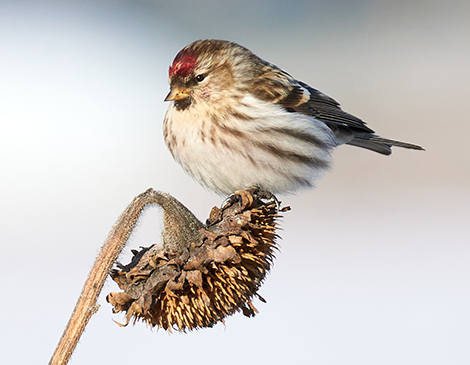
Looking to get a start with birding? Northeast Ohio is a good place to be. Organized birding meetups are numerous; the Cleveland Metroparks consistently offers group bird walks, even in the winter. Some spots, like the Brecksville Reservation, allow visitors to hand-feed songbirds during program hours. Just a few hours away, Oregon, Ohio (a hot spot for warbler sightings), hosts the Biggest Week in American Birding event every May.
But when it comes to the great snowy owl — the most powerful presence of a Cleveland winter sky — look to the lake.
“Where the city meets the lake, that is the winter birding honey hole,” Calabrese says. “It really is the lure, the magic, of Lake Erie. Nowhere attracts the birds and hardened birdwatchers like water, like Lake Erie. The Cuyahoga River is a close second with its winding corners, attracting droves of ducks.”
This winter, watch for sightings on bird app forums, and get ready to head out quickly to catch a sight of the majestic creature. If sighted at Burke Airport, stop on North Marginal Road to try to spot it; if the owl is at Hopkins, the parking lot for the Aviator Pub & Restaurant serves as a good view, says Calabrese.
Remember to keep your distance. Snowy owls are busy hunting during the day and shouldn’t respond to disruptive birders or photographers. Patience is key.
“Just be patient. If you’re out there and you’re trying to get it to do something, then you’re really not doing it right,” Alex says. “It’s about patience and waiting for it. You can’t really manipulate a bird.”
The chances of seeing a snowy owl are low but not zero. Still, why not look for other birds while you’re at it, too? Here are some other feathered friends to watch for this winter in Northeast Ohio:
Northern Saw-whet Owl
The Northern saw-whet Owl gets attention for being tiny. One of the smallest owls, this creature usually weighs less than four ounces and is seven or eight inches long.
RELATED: This Little Owl Was Found in Public Square's Christmas Tree
Harlequin Duck
The harlequin duck is named after colorful costumed theatrical characters. While females are brown, males are patterned with brown, white and blue markings.
Dark-eyed Junco
The original “snowbirds!” The dark-eyed junco’s arrival is known to predict snowy weather. You’ll see the sparrows fluffed up for winter with a white belly and black wings.
Red-tailed Hawk
All birders marvel at the massive raptors that hunt other creatures year-round in Ohio. Red-tailed hawks are a common bird of prey with distinctive
auburn red tail feathers.
Golden crowned Kinglet
A puff of orange or yellow encircles the head of this tiny songbird, which is barely bigger than a hummingbird and regularly winters here and in other frigid environments.
Tufted Titmouse
Not all songbirds ditch Ohio when cold weather lands. A pointy tuft of gray feathers gives this bird’s head expressive character and makes for an easy ID for beginner birders.

Annie Nickoloff
Annie Nickoloff is the senior editor of Cleveland Magazine. She has written for a variety of publications, including The Plain Dealer, Alternative Press Magazine, Belt Magazine, USA Today and Paste Magazine. She hosts a weekly indie radio show called Sunny Day on WRUW FM 91.1 Cleveland and enjoys frequenting Cleveland's music venues, hiking trails and pinball arcades.
Trending
-
1
-
2
-
3
-
4
-
5










